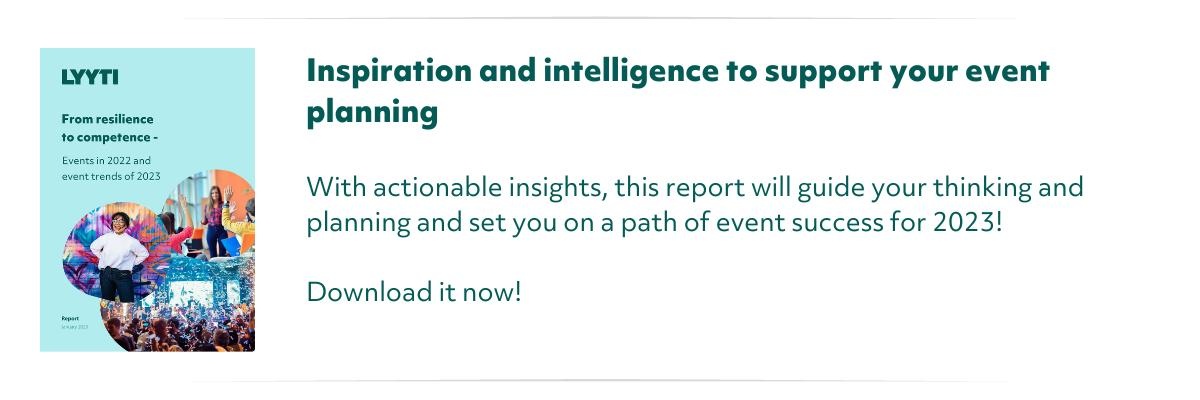No-shows are every event organiser's worst nightmare since every event aims to get as much people to arrive to the event as possible. A no-show refers to individuals who have registered for an event but, for some reason, do not attend and fail to notify the organiser.
Organising, communicating, and managing an event requires significant resources. For example, the venue and potential drinks and treats are always arranged according to the number of participants. It's truly disheartening when the number of no-shows remains high, and carefully crafted messages and content fail to reach all those interested in the event.
What methods does an event organiser have to reduce no-shows? And how can you benefit from those who ultimately didn't show up?
Carefully plan event communication
The event is approaching, and the attendee list looks promising. You have managed to attract participants from your target audience, and the number of attendees has exceeded your expectations. However, you now face another challenge: how do you ensure that participants show up?
Communication is one of your most important tools. Send targeted messages in the weeks leading up to the event, and increase the frequency of communication as the event draws near. Reminders such as "See you at next week's event," "The event is approaching," and "See you in half an hour" are effective in keeping your event top of mind for participants.
One hugely succesful event had a communication plan of 17 messages for a participant who attend the event and 13 of the messages were sent before the event actually started.
So tips about content to share:
- Send pictures and small previews of the event's content to build participants' expectations.
- Including video greetings from the event's speakers or organisers, personally thanking the registrants and welcoming them to the event.
- Tell the participants who else is going to attend and if participants can benefit from networking.
- Build up the size or the exclusivity of the event.
Highlight sustainability
Sustainability is a theme that nowadays defines all areas of corporate activity. Events are no exception. Companies are expected to take responsible actions when organizing events.
Sustainability includes using ecologically sustainable travel options, utilizing environmentally friendly products, and serving sustainably produced food.
However, one aspect often receives less attention: what if a registered person, who has been registered to event, doesn't show up? At the end, size of the venue as well as amount of food and drinks are tallied up to match the number of attendees.
Emphasise the desire to act responsibly and ask participants to cancel their participation if they are unable to attend. The boldest event organisers charge participants a fee if they fail to show up without notifying the organiser.
Most of us want to act responsibly, so highlighting this aspect may help mitigate no-shows.
Make canceling participation easy
People will inform you of their unavailability or cancel their participation if it's quick and effortless. Most event management systems offer the ability to modify registrations. You can include a cancellation link in every outgoing event-related message, making it easy for participants to notify you if they can't attend.
If the participant costs for your event are particularly high, you can even dedicate one of the event-related messages to emphasise the option to cancel. It's always better to act responsibly, even if it means losing one participant.
No-shows are not the end of the world
Sometimes situations change, and even the most interested participant may not show up. The reason may be a sudden illness or another factor beyond the participant's control. However, all is not lost. You have a known interested person who has expressed a desire to receive your content.
For those who didn't show up, it's worth building a workflow or other follow-up communication plan to share the missed content and direct them to register for the next event.
You can also suggest a meeting where the participant can personally discuss the event's topic. You'll be surprised at how effective this approach is for booking appointments.
Sharing event atmosphere images and videos is a good way to ensure that participants don't miss your next event.
To wrap things up
No-shows are an unfortunate part of an event organiser's life. The most important thing is to ensure that the portion of participants who are no-shows is as small as possible. Develop your own strategy for no-show participants to actively engage with them. Here are a few easy tips for reducing no-shows:
- Remind, remind, and remind again - carefully planned and executed communication reduces no-shows.
- Emphasise participant responsibility - explain the impact of no-shows, such as the quantity of food offered.
- Facilitate cancellation of participation, so you can prepare for the correct number of participants.
- Create your own post-event marketing funnel for those who didn't show up and guide them to the next event.
- Build FOMO (Fear of Missing Out) and share pictures and videos of the event - they won't want to miss it again!
Download our template to build the perfect event marketing and communications plan.
Hero image by Nacho Capelo









